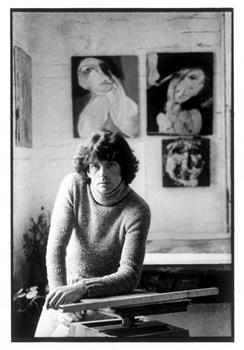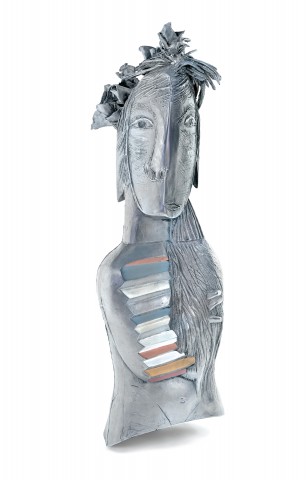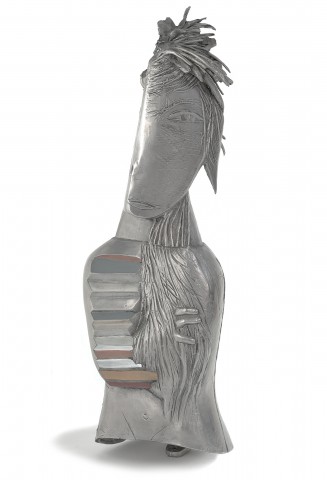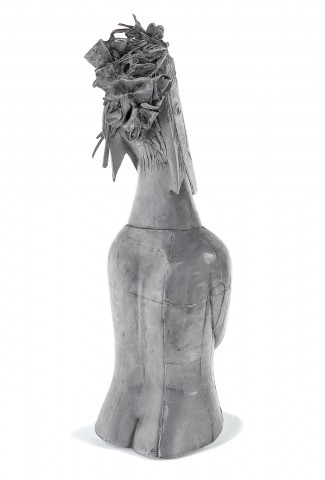THREE-SIDED PERSONAGE, 1974
GEORGE BALDESSIN
cast 2004
enamel paint on cast aluminium
102.0 x 31.0 x 33.0 cm
inscribed with artist’s monogram and numbered at base: gB 2/4
bears Meridian Melbourne, foundry mark at base
The estate of the artist
Australian Galleries, Melbourne
The National Australia Bank Art Collection, acquired from the above in October 2006 (label attached to base)
Springfield Art Show in aid of the Association for the Blind, Melbourne, 26 – 29 September 1974 (another example)
George Baldessin: Sculpture and Etchings, National Gallery of Victoria, Melbourne, 8 August – 18 September 1983, cat. 124 (another example)
George Baldessin, TarraWarra Museum of Art, Victoria, 21 November 2009 - 14 March 2010 (another example)
Baldessin/Whiteley Parallel Visions, Ian Potter Centre, National Gallery of Victoria Australia, Melbourne, 31 August 2019 – 28 January 2019 (another example)
Lindsay, R. and Holloway, M. J., George Baldessin: Sculpture and Etchings, National Gallery of Victoria, Melbourne, 1983, cat. 124, p. 136 (illus., another example)
Edquist, H., George Baldessin: Paradox & Persuasion, Australian Galleries Publishing, Melbourne, 2009, pp. 164, 165 (illus.), 250 (another example)
Grishin, S., Baldessin/Whiteley Parallel Visions, National Gallery of Victoria, Melbourne, 2018, pp. 124 (illus., another example), 193
210747.jpg

George Baldessin experienced meteoric success from the moment of his first solo exhibition at the Argus Gallery, Melbourne in 1964 – described by critic Alan McCulloch at the time as ‘the most impressive debut of any Australian born sculptor in the last 20 years’1, until his untimely death in a car accident in 1978. During this brief fourteen-year period, Baldessin exhibited widely and to much acclaim within Australia and internationally (including representing Australia with fellow artist, Imants Tillers, at the Bienal de São Paulo, Brazil in 1975), and both his prints and sculptures were acquired by state galleries, including by the then-new Australian National Gallery (now National Gallery of Australia).
An Italian immigrant who arrived in Australia at the age of ten, Baldessin studied art at RMIT (the Royal Melbourne Institute of Technology) from 1958 to 1961. Yet despite graduating with a Diploma of Fine Art in Painting, it was the printmaking and sculpture studios that held thrall for the young artist, and he was particularly influenced by his teachers in these areas – sculptor Lenton Parr (1924 – 2003) and printmaker Tate Adams (1922 – 2018), the latter of whom was to become a lifelong friend. Importantly, for Baldessin, his relationship with Adams also provided access to the Thursday evening (and later, Friday) etching classes that were reserved for practicing artists, and he swiftly found himself amongst an experienced cohort that included John Brack, Leonard French, and Fred Williams. During this time, Williams was editioning his etchings of audiences and performers at the London Music Hall, created during his part-time studies at London’s Chelsea School of Art, and these were to greatly inspire Baldessin’s own, now highly-recognisable images of trapeze artists, acrobats and performers.2 A notoriously hard worker, and one who was obviously always keen to continue to learn, Baldessin went on to study printmaking at Chelsea School of Art in 1962 (again influenced by Williams), followed by a period at the Brera Academy in Milan in 1963 under the tutelage of Marino Marini (1901 – 1980) and his studio assistant Alik Cavaliere (1926 – 1988), who was to greatly influence Baldessin’s work in three-dimensions.
Baldessin’s print and sculptural practice fed off one another, and an active process of recycling involving returning to, and reworking of, various motifs, images and interests, is evident across his oeuvre. While his work in both mediums contains lyrical passages of abstraction, he remained committed to figuration, and particularly, to the female form, with its mystery and ‘otherness’, and its fleshy physicality. As he said: ‘Not only am I interested in things that are derived from the human body, but a particular aspect of the human body – that is distorted human bodies, I’m not for these… so‑called attractive reproductions of the human body. I want my figures to have a kind of inner impetus.’3
Baldessin began experimenting with aluminium, a ‘futuristic’ medium that encapsulated an undeniably Pop Art aesthetic, in the mid 1960s. As a material, it had several advantages: it had a low melting point, which lessened casting problems; it could be easily fabricated; and importantly, for the young artist, it was inexpensive, light, and came in sheets.4 The artist’s aluminium sculptures are also closely related to his innovative silver foil prints, which were complex to produce (with a strike rate of one in five), and whose highly reflective surfaces mimicked the appearance of ‘the shiny, inked-up plate with the iridescent quality of the light reflected on the polished plate surface’.5 Interestingly, this ongoing dialogue between sculpture and printmaking is powerfully captured in Three-Sided Personage, 1974 where the artist’s expressive incisions directly into the mould from which the sculpture is cast are not unlike the practice of etching into a metal plate. As Elizabeth Cross has noted, ‘…the surface as animating force in a work of art was central to Baldessin’s art.’6
With its combination of two profiles, Three-sided Personage is an intriguing work which captures a sense of both internal struggle and existential angst, made manifest upon the body. One side of the figure’s torso bears a concertina-like architectural element that appears throughout Baldessin’s work, while the other may well be wearing the hairshirt associated with Mary Magdalene that Baldessin recreated in his depictions of the saint after seeing such imagery during his travels in Europe. As Baldessin recalled, ‘In Paris I used to walk down the Rue Saint-Denis, the prostitutes’ street, and as autumn was coming on, I noticed that the girls, the Madeleines of Rue Saint-Denis, started wearing a kind of rusty red-coloured fur coat… They were twentieth-century Mary Magdelenes walking the street of Les Halles and near the Georges Pompidou Centre … the Madeleine of my drawings became the personage which wasn’t the Rue Saint Denis prostitutes and wasn’t the Mary Magdalene but was both’.7 Deliberately enigmatic and elusive, the figure’s bifurcated face gives little away. As this and other titles of the artist’s work suggest, are Baldessin’s ‘personages’ simply playing a role?
1. McCulloch, A., The Herald, 16 June 1964 as quoted in Lindsay, R. & Holloway, M.J., George Baldessin: Sculpture and Etchings. A Memorial Exhibition, National Gallery of Victoria, Melbourne, 1983, p. 30. As Baldessin’s friend and fellow artist Jan Senbergs recalled of this exhibition: ‘… anyone who was there at the time realized they were witnessing the emergence of a major talent who was going to make a definite mark on the Australian scene…’: see Senbergs, J., ‘Recalling George’ in George Baldessin Prints 1963-1978, Australian Galleries, Melbourne, 1997, p. 6
2. See Lindsay & Holloway, ibid.
3. Baldessin / Whiteley: Parallel Visions exhibition labels, National Gallery of Victoria, Melbourne, 2018, https://www.ngv.vic.gov.au/wp-content/uploads/2018/08/Baldessin-Whiteley... (viewed 16 December 2021)
4. Lindsay & Holloway, op.cit., p. 120
5. ibid., p. 78
6. Cross, E. ‘George Baldessin 1939 – 1978’ in George Baldessin Prints 1963 – 1978, op. cit., p. 16
7. Baldessin / Whiteley: Parallel Visions exhibition labels, op. cit.
KELLY GELLATLY


